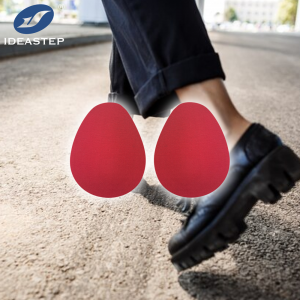
Metatarsal pads, also known as metatarsal cushions or metatarsal supports. In the previous blog”A Comprehensive Introduction To Metatarsal Pads: Understanding Benefits And Applications“, we discussed the benefits and applications of metatarsal pads. In this article, we will explore the various materials used for metatarsal pads and their implications for foot health and comfort.
1. Gel-Based Metatarsal Pads
Gel-based metatarsal pads are a popular choice due to their soft and cushioning properties. The gel material conforms to the shape of the foot, providing targeted support and pressure relief to the metatarsal heads. Gel pads are effective in redistributing weight and reducing pressure on the forefoot, making them suitable for individuals with metatarsalgia, Morton’s neuroma, or other forefoot conditions. The pliable nature of gel also allows for a comfortable fit in a variety of footwear, from athletic shoes to dress shoes.
2. Foam-Based Metatarsal Pads
Foam-based metatarsal pads, often made from materials such as EVA (ethylene-vinyl acetate) foam or PORON®, offer a balance of cushioning and support. These materials provide shock absorption and reduce pressure on the metatarsal heads, making them beneficial for individuals seeking additional comfort and protection in the forefoot area. Foam pads are lightweight and can be easily trimmed or customized to fit different shoe styles, making them a versatile choice for addressing metatarsal pain.
3. Silicone-Based Metatarsal Pads
Silicone-based metatarsal pads are known for their durability and long-lasting resilience. The silicone material offers a firm yet flexible support, effectively dispersing pressure and providing cushioning to the metatarsal area. Silicone pads are suitable for individuals requiring consistent support and impact absorption, and they can withstand prolonged use without losing their shape or effectiveness. Additionally, silicone pads often feature a non-slip surface to prevent shifting within the shoe.
4. Fabric-Covered Metatarsal Pads
Some metatarsal pads feature a fabric cover, which can be made from materials such as felt, suede, or breathable mesh. The fabric covering serves to enhance comfort, reduce friction, and prevent moisture buildup around the metatarsal area. Fabric-covered metatarsal pads are gentle on the skin and can be an ideal choice for individuals with sensitive or easily irritated skin. The fabric cover also adds a layer of protection and prevents the pad from sticking to the foot during prolonged wear.
Considerations for Material Selection
When choosing a material for metatarsal pads, it’s important to consider factors such as the individual’s foot shape, the specific condition being addressed, and the intended use of the pads. Additionally, the material’s breathability, ease of cleaning, and compatibility with different types of footwear should be taken into account to ensure optimal comfort and functionality.
The selection of material for metatarsal pads significantly influences their performance and user experience. If you are interested in metatarsal pads or heel pads, you can continue to visit this page (https://www.aideastep.com/heel-pads/) and tell us your needs.
